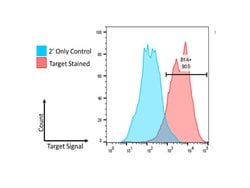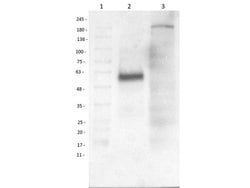Learn More
beta 1 Adrenergic Receptor Polyclonal Antibody, Rockland™


Rabbit Polyclonal Antibody
$174.73 - $636.24
Specifications
| Antigen | beta 1 Adrenergic Receptor |
|---|---|
| Concentration | 0.97 mg/mL |
| Applications | ELISA, Flow Cytometry, Immunohistochemistry, Western Blot |
| Classification | Polyclonal |
| Conjugate | Unconjugated |
| Catalog Number | Mfr. No. | Quantity | Price | Quantity & Availability | |||||
|---|---|---|---|---|---|---|---|---|---|
| Catalog Number | Mfr. No. | Quantity | Price | Quantity & Availability | |||||
50-199-2308
 
|
Rockland Immunochemicals
600401MH1 |
100 μg |
Each for $636.24
|
|
|||||
50-199-2309
 
|
Rockland Immunochemicals
600401MH1S |
25 μL |
Each for $174.73
|
|
|||||
Description
Store vial at -20°C prior to opening. Aliquot contents and freeze at -20°C or below for extended storage. Avoid cycles of freezing and thawing. Centrifuge product if not completely clear after standing at room temperature. This product is stable for several weeks at 4°C as an undiluted liquid. Dilute only prior to immediate use. This affinity purified antibody is directed against human beta 1 adrenergic. A BLAST analysis was used to suggest cross-reactivity with the antigen based on 100% homology with the immunizing sequence to human, mouse, rat, and rhesus macaque.
Adrenergic receptors (ARs) are members of the 7-transmembrane domain G-protein-coupled receptor superfamily that bind the endogenous catecholamines epinephrine and norepinephrine. Pharmacological, structural, and molecular cloning data indicate significant heterogeneity within this receptor family. Nine receptor subtypes have been identified thus far including three alpha-1 AR subtypes (1A/D, 1B, and 1C), three alpha-2 ARs (2A, 2B, and 2C), and three beta AR subtypes (1, 2, and 3). ARs participate in either the onset or maintenance of several disease states including hypertension, cardiac dysfunction (congestive heart failure, ischemia, arrhythmias), diabetes, glaucoma, depression, and impotence. BARs participate in diverse processes including development, behavior, cardiac function, smooth muscle tone, and metabolism. In gene-knockout experiments, the majority of mice that lack the B1AR gene die prenatally and those that do survive until adulthood display abnormal cardiac function. Other studies have shown that the direct regulation of cardiac B1AR density by thyroid hormones occurs at the transcriptional level and is modulated by the catecholamine sensitive-adenylyl cyclase system. Evidence for the effects of cAMP on B1AR regulation has come from a study of members of the cAMP response element (CRE) modulator (CREM) family of transcription factors in transformed cell lines.Specifications
| beta 1 Adrenergic Receptor | |
| ELISA, Flow Cytometry, Immunohistochemistry, Western Blot | |
| Unconjugated | |
| Rabbit | |
| Human | |
| P08588 | |
| 153 | |
| Primary | |
| Antibody |
| 0.97 mg/mL | |
| Polyclonal | |
| Liquid | |
| RUO | |
| 0.02M potassium phosphate with 0.15M NaCl and 0.01% sodium azide; pH 7.2 | |
| Adrb1; Adrb-1; Adrb1r; adrenergic receptor, beta 1; adrenergic, beta-1-, receptor; adrenoceptor beta 1; B1AR; beta 1-adrenergic receptor beta 1-AR; beta 1-AR; Beta-1 adrenergic receptor; Beta-1 adrenoceptor; Beta-1 adrenoreceptor; BETA1AR; beta-AR; cardiac beta adrenergic receptor; RATB1AR; RHR | |
| ADRB1 | |
| -20°C, Avoid Freeze/Thaw Cycles | |
| ADRB1 |
The Fisher Scientific Encompass Program offers items which are not part of our distribution portfolio. These products typically do not have pictures or detailed descriptions. However, we are committed to improving your shopping experience. Please use the form below to provide feedback related to the content on this product.

